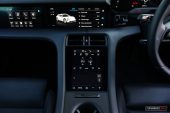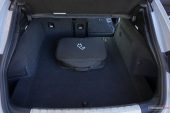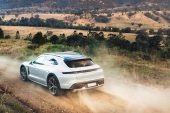Say hello to the quickest-accelerating station wagon we’ve ever tested, and probably the quickest wagon currently on the market. It’s the Porsche Taycan Turbo Cross Turismo.
Firstly, no. It does not feature a turbocharger; this is a fully electric vehicle and one of many on the way from the storied German car manufacturer. So what’s the deal with the ‘turbo’ name? This badge has traditionally been used on all flagship models in the Porsche range, and so it is the case here as well.
Confusion aside, it certainly goes like a turbo. Belting out up to 500kW of power, it is one of the most powerful wagons on the market as well. In fact, we can’t think of any other wagon on sale today (in Australia) that develops more power – the 500kW Panamera Turbo S E-Hybrid Sport Turismo was last available here in 2020. That’s an awesome boast.
Unlike the Taycan sedan, the new Cross Turismo crossover is not available in Turbo S trim. For now the regular Turbo sits at the top of the range. Prices start from $284,600, which is a lot. However, compared with the 404kW Panamera Turbo Sport Turismo which starts from $397,900, this is a bargain. And it’ll do 0-100km/h in under 3.3 seconds, compared with 3.8 seconds in the V8.
Interestingly, the Cross Turismo Turbo is only $3000 more than the Taycan Turbo sedan. Only 15kg heavier, too.
2022 Porsche Taycan Turbo Cross Turismo – THE SPECS
[column width=”47%” padding=”6%”]Motor: Two AC synchronous
Battery: 93.4kWh (Performance Plus)
Output (combined): 460kW (500kW overboost) / 850Nm
Transmission: Single-speed front, two-speed rear axle
Drive type: All-wheel drive
Wheels: F: 20×9.0, 245/45 R: 20×11.0, 285/40 (optional 21s fitted)
ANCAP: Not tested
Unladen weight: 2320kg
Power-to-weight: 4.64:1 (kg:kW)[/column] [column width=”47%” padding=”0″]Official range: 425km
0-60km/h: 1.67 seconds*
0-100km/h: 3.21 seconds*
0-200km/h: 10.41 seconds*
60-110km/h: 1.97 seconds*
1/4 mile: 11.08 seconds at 206.2km/h*
Max acceleration: 1.151g
100-0km/h braking: 2.96 seconds at 35.45 metres*
Max deceleration: -1.242g
Decibel at idle: 23*
Peak decibel at 60-100km/h: 77*
Priced from: $284,900[/column][end_columns]
* Figures as tested by PerformanceDrive on the day. Factory claims may be different
2022 Porsche Taycan Turbo Cross Turismo – THE PACKAGE
We keep calling it a wagon but it’s actually pitched as a crossover. The standard air suspension provides 20mm of extra ground clearance compared with the Taycan sedan, and there is a Gravel driving mode which alters various settings for increased off-road capability. Look, it’s not as adventurous as a Cayenne off road, but it can tackle rough-ish dirt roads and grassy tracks much better than most sedans. There is an optional Off-Road package available as well that lifts ground clearance by a further 30mm.
Lower skirting around the bodywork is also protected by black, scratch-friendly moulding, with silver skid-plate-like garnishes for the front, rear and sides. It has the styling characteristics of a rugged SUV but with the low and sleek profile of a cool shooting brake wagon. It’s a unique and attractive combo we think.
This test car wears a set of optional 21-inch Porsche Design alloy wheels, wrapped in low profile 265/35 front, and whopping 305/30 rear Pirelli P-Zero tyres. This is not an ideal setup for off-roading, obviously, but you can stick with the original 20s with higher-profile 245/45 front and 285/40 Goodyear Eagle F1 tyres if you regularly drive on dirt roads. We’ve included some press photos of alternative wheel options for reference.
Inside, it is typically clean and clutter-free, but with loads of technology lurking in the background. This test car features the twin 10.9-inch touch-screens across the dash, including one for the passenger, and then a curved 16.8-inch screen for the driver’s gauge cluster. This latter screen features touch-selectable areas on the wings which can be configured to display various info layouts. To change these you simply use the controls on the steering wheel.
The graphics are very sharp and crisp and most menus are fairly straight-forward to navigate, although we feel like there are a few menus that end up in odd dead-end areas of the screen realestate. A bit more colour would be interesting too, but then that might detract from the brand’s reserved in-car themes. As a side note, Porsche announced its latest PCM 6.0 operating system in February this year which does actually promise more colour and graphical enhancement. (This test vehicle was built before the new system was introduced but all new orders get 6.0 included.)
You do sit quite low in the Cross Turismo, despite being a crossover. In fact, it feels much like a sports car sitting in here, requiring a proper bend down to get in and a mild leg-press heave to get out. If you are looking for an easy-access platform typical of an SUV, you are better off checking out the Cayenne in that respect. The seat design and pulled-forward dash are clearly inspired by and carry through the tradition of the 911, and the driving position is so good you just want to sit in here all day.
Buyers can opt for the standard four-seat layout with two back seats, or opt for the 4-plus-1 layout as featured here for around $1000. Legroom is pretty good on the outer seats but tighter in the middle due to the thick driveline tunnel. Headroom is quite decent, especially with the optional panoramic glass roof providing a deeper cutaway in the ceiling, as featured here.
Adopting a wagon layout means this is the option for you if practicality is a high priority. The rear seats can be folded down, totally flat, opening up almost 1200 litres of volume. And there’s some handy storage under the floor for the charging cables, as well as a 12 volt socket and securing straps on the wall. Under the bonnet is an additional 84 litres of cargo capacity, big enough for a weekend bag or light shopping – we actually prefer this space for the shopping as the tighter box-like cavity tends to keep bags from rolling about.
2022 Porsche Taycan Turbo Cross Turismo – THE DRIVE
Underneath the body is the J1 platform similar to what is found under the Audi e-tron GT, stemming from VW Group’s MSB platform from products like the Bentley Continental GT and current Panamera. However, being an electric vehicle the core of it is completely unique. In the middle sits a large seal-welded aluminium battery frame which is also protected by a steel plate underneath to shield against debris from the road. Inside that is a two-deck 93.4kWh battery, called the Performance Battery Plus. It provides a driving range of 425km, according to the WLTP cycle.
At either end, the layout is suspended by a double-wishbone setup at the front made from forged aluminium with cast aluminium swivel bearings, and a multi-link configuration at the back with forged aluminium for the upper wishbones and hollow-cast aluminium for lower members. Needless to say, the attention to detail on lightness is evident. All variants in Australia come with adaptive air suspension as standard and all-wheel drive (dual motors), with the flagship Turbo also featuring Porsche Torque Vectoring Plus (PTV Plus) and Porsche Dynamic Chassis Control (PDCC Sport) as standard – optional on lesser variants.
On the road this setup feels comfortable and absorbent, much like a more luxury-focussed SUV to be honest. It soaks up bumps and undulations with a surprisingly wide tolerance while remaining completely controlled and connected to the road. We were blown away by the ride comfort in the Taycan Turbo sedan, mainly due to its ability to catch sudden impacts and almost completely hide them from passengers inside. Well, the same can be said of the Cross Turismo. If anything this offers slightly more suspension compression range so it has the potential to absorb nastier bumps while remaining utterly compliant.
The handling is fluid yet direct, with a suitable steering ratio for both tight and twisty turns and more open-road style country bends. This test car features the rear-axle steering system ($4300) which means the rear wheels can pivot in the opposite direction to the front during tight/slow corners and pivot in the same direction in higher-speed arcs. Essentially, it means the car can hook around hairpins and navigate small carparks better than the standard setup, while offering improved stability during higher speeds, including amazing lane-changing smoothness. It feels like it is gliding.
Power comes from a 175kW/300Nm electric motor at the front axle, sending force to the wheels via a single-speed gearbox. The package is water-cooled. Meanwhile the back houses a larger motor developing 335kW/550Nm, matched to an integrated two-speed gearbox. We’re not sure how the rear end doesn’t overtake the front, but Porsche says the all-wheel drive distribution is automatically managed and fully variable. That includes dividing torque between not just the front and rear but also side-to-side. During cruising the system is optimised for efficiency.
Around corners the grip levels are truly immense. You can dive deep into a bend, apply a boot-full of throttle and the car rips around like a toy car being catapulted in one of those Hot Wheels Curve Kicker boosters. The g-force is massive, and if you’re not used to this kind of thing we’d recommend slowly warming up speed levels before applying full power, as the force can disorient your focus. It’s that intense. The potential, anyway.
Speaking of intense, straight-line acceleration utterly blows your mind and anyone else’s game enough to be in the car. Porsche claims 0-100km/h in 3.3 seconds, 0-200km/h in 10.7 seconds, and the 0-400m sprint (similar to 1/4 mile) in 11.1 seconds. With the battery level at about 75 per cent, we timed some runs on a private road using a Racelogic Vbox Sport. We saw 0-100 come up in 3.21 seconds, 0-200 done in 10.41 seconds, and the 1/4 mile achieved in just 11.08 seconds. Porsche is one of the only manufacturers we’ve come across that provides not only astonishing acceleration claims but also figures that can actually be achieved in the real world.
As mentioned at the beginning of this review, this is the quickest-accelerating wagon we’ve ever tested. You can check out full performance data table here to see all of our results, compiled over about seven years of testing. By the looks of it, the next-quickest wagon we tested was the Alpina Bi-Turbo Touring, which achieved 0-100km/h in 3.71 seconds using a 447kW twin-turbo V8, or the 478kW twin-turbo V8 Lamborghini Urus with a time of 3.44 seconds if you want to include SUVs. And against those models, the Taycan Turbo Cross Turismo is reasonably priced.
So, what about the range and recharging? The Taycan uses an 800V electrical system and it can recharged at up to 350kW. However, in Australia such power outlets are pretty rare. ChargeFox does have some stations around, and they do cost money to use. We have used one with another EV and the bill was $29.66, taking the battery level to around 30-100 per cent.
For this test we only used a 50kW station as it was closer to our home. You can expect a big charge to be achieved in about 1.5 hours using a 50kW outlet. And by big we mean from about 20-100 per cent. Topping up from, say, 50 per cent to 80 per cent requires much less time (about 30 minutes). This is because the last 20 per cent is supplied at a slower rate to optimise battery durability.
2022 Porsche Taycan Turbo Cross Turismo – THE VIDEO
2022 Porsche Taycan Turbo Cross Turismo – THE VERDICT
The acceleration, grip, and sheer power – available instantly – from this wagon is truly epic. It is perfectly fitting and deserving of the famed Turbo badge in our opinion. The price is more attainable than a like-minded petrol model from Porsche, and even lower than some of its nearest rivals on the market. But most importantly of all, it feels like a Porsche, inside and out.
You get that wonderful communication through the steering, rock-solid build quality, and a distinctively reserved and driver-focussed cabin. The only part we don’t like is the lack of engine sound. Particularly for a flagship performance model. If this was the base model, the luxury-like EV serenity goes well we think. But for absolute excitement, the more senses pleasured the better, in our opinion.
[column width=”47%” padding=”6%”]PROS:
– Unbelievable acceleration and instant throttle response, up to 500kW
– Steers and handles like a dream sports car
– Air suspension provides properly luxurious ride
– Porsche’s exceptional build quality
– More affordable than equivalent Panamera V8 (actually a lot quicker too)
– Only $3000 more than the sedan, and just 15kg heavier
[/column] [column width=”47%” padding=”0″]CONS:
– Lagging Australian EV infrastructure tarnishes usability and overall appeal
– Silent performance isn’t as exciting as revving an exotic engine (in our opinion)[/column][end_columns]
As always, if you’re thinking about buying a new car don’t forget to click here to speak with our car buying specialists.


































